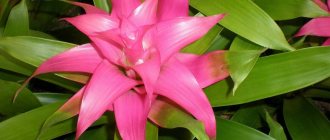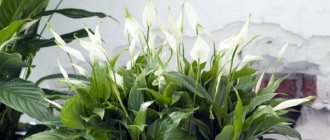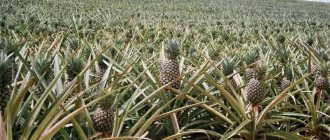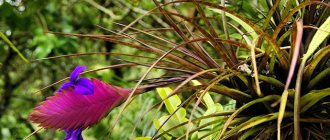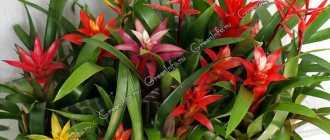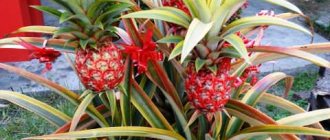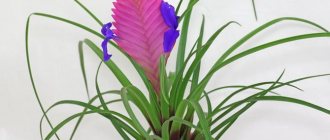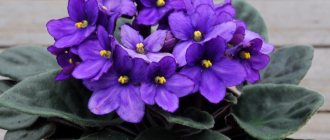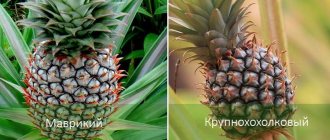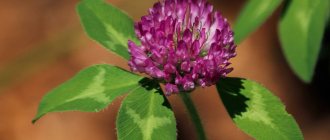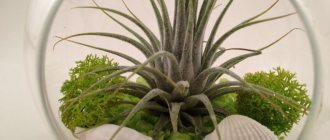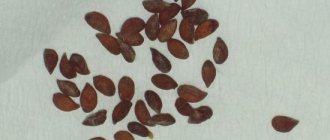Family Bromeliads
Plants in the Bromeliad family originate from the tropics, and several species have been found in the American subtropics and one in western Africa.
Bromeliads are epiphytes, meaning they grow on trees, rocks or other plants and obtain water and nutrients from the air and rainwater. Unlike most plants, they do not receive the necessary substances from the root system. Their roots are just a way to join the growing support.
Bromeliad
Almost all members of the Bromeliad family are characterized by the presence of a short stem and long urea-shaped leaves that are attached to each other and form a funnel. The structure of the leaves is simple: in some representatives of the species they are wide and dense, in others they are thin with a loose structure. Depending on the species, the inflorescence can be capitate, racemose or paniculate.
Types and characteristics of indoor plants from the Bromeliad family
There are about 3,000 different types of these flowers, among them: cryptanthus, guzmania, vriesia, indoor pineapple, aechmea, neoregelia, billbergia, acanthostachis, neoregelia, nidularium and many others.
Note! Those who have heard the name Bromeliad de Zapata and want to buy this flower need to know that it does not exist, it is an April Fool's joke.
Reproduction
If you decide to propagate your bromeliad, then you should wait until the end of flowering. During this period, the bracts lose their color, becoming faded, and new shoots appear near the base of the rosette. Give them a few months to mature so that they have time to get stronger and acquire their own roots and leaves. Usually, their transplantation begins from February to April, when the sprouts gain strength and are ready for independent life.
To obtain a seedling, you need to cut off a young rosette with a very sharp knife, then lightly dry it and sprinkle crushed charcoal on the cuts to disinfect it. Then suitable soil is poured into the pot, and the seedlings are firmly fixed. Until the plant is completely established and the root system appears, you should only lightly water the soil, and in order to quickly achieve this result, it would be optimal to create greenhouse conditions. Usually, after a couple of months, bromeliad takes root well, and the first flowers will appear on it within one and a half to two years, but this can only be achieved in cases where proper care is taken.
How to care for these plants at home
Bromeliad - home care, watering and propagation
Almost all bromeliads are adapted to warm, humid, shady climates. Their original habitat is moist and they grow under the shade of trees or are attached to them.
Important! Bromeliads do not tolerate exposure to large amounts of direct sunlight.
Temperature, humidity, light
The optimal temperature for bromeliads is considered to be in the range of 15-26 ºС, but they can survive in very hot climates.
Bromeliad indoor plants require 60% air humidity. This level is difficult to maintain, especially in winter when the house is heated.
Ways to humidify the air:
- place a humidifier near the plant;
- place a tray with moisture, for example, place pebbles and decorative elements in a deep large bowl and fill with water;
- move several plants closer to the bromeliad, due to the process of transpiration, the humidity next to it will increase;
- Regularly spray the flower from a bottle with an aerosol tube.
Light
Not all varieties of bromeliads prefer bright, indirect light; some grow better in constant shade. In winter, they need to be moved to a south-facing window.
Optimal soil for Bromeliads
For these representatives of the fauna, loose soil is suitable, which mainly consists of high-moor peat with the addition of leaf soil and sand. The soil for Bromeliads is diluted with bark, coal, coniferous soil, and chopped sphagnum.
Tillandsia - a plant without roots
Hatiora - home care: air humidity and other requirements
Tillandsia aerial or atmospheric is an exotic plant of the Bromeliad family. The most popular representative of the genus, requiring difficult care.
Tillandsia
The main way to obtain moisture from Tillandsia without roots is through the leaves, which need to be sprayed regularly. To grow this flower, it needs to be provided with a cozy atmosphere with diffused lighting (about 14-15 hours a day), without drafts, and with clean fresh air. The optimal temperature for this representative of Bromeliads is 20-25 ºС.
How to replant
Tillandsia rootless requires replanting only once after purchasing it in the store. When the plant fades, it dies, so it does not need to change the soil.
Variety of species
There are about 500 species of this representative, including: Tillandsia Albida, purple, broad-leaved, moss-like, large, two-flowered, Butza, etc.
Pineapple as an indoor potted plant
Solanaceae family - characteristics of nightshades
Homemade pineapple will surprise not only guests at home, but will also delight the owner’s eye all year round. Indoor pineapple is a decorative flower.
Homemade pineapple plantation
Caring for indoor pineapple
You can grow a pineapple at home in a pot if all the conditions are created and caring for it does not require much effort. This plant does not need pruning, only replanting in spring and summer. To plant a pineapple, you need to cut off a rosette, which is washed in a solution of potassium manganese. Next you need to sprinkle the cut with ash and let it dry. Then the rosette is transplanted into a pot (0.4-0.6 l), into which a drainage layer and a loose earthen mixture of leaf humus, turf soil, sand and peat are poured (ratio 1:2:1:1).
A description of how to grow pineapples at home is presented below.
Temperature, humidity and light
Indoor pineapple is a heat-loving plant, a unique specimen of the floristic kingdom. In summer it grows well at 25-28 °C, and in winter 22-24 °C.
Pineapple does not require high levels of air humidity and thrives in dry climates. Requires regular spraying with water at room temperature.
Important! This representative of Bromeliads is light-loving, but does not need direct sunlight.
Watering mode
Pineapple should be sprayed regularly and also watered with settled water at room temperature every day.
Important! In winter, the flower should dry out; it does not need to be sprayed or watered a lot.
Soil and fertilizers
The soil for the plant should consist of expanded clay, charcoal, broken bricks and soil.
You can add mullein infusion to the mixture (for 4-5 days) during the period of active plant growth.
Note! Alkaline fertilizers and wood ash should not be added.
Bromeliad: transplantation after purchase
Transplantation for this representative of epiphytes is not required at all, because it can cause the plant to die. The only reason why this procedure can be carried out is an overgrown root system and an unsuitable small pot. To do this, choose a new flowerpot that is a couple of centimeters taller and wider than the old one, and prepare the soil yourself.
The choice of soil mixture can be approached without special criteria, because the main difference between a flower and other houseplants is the ability to adapt to any conditions. If you have a list of ingredients at home: sand, peat, garden graphite, and leaf humus, then you can mix them in equal proportions, except for the last component. Soil mixture for orchids purchased without much hassle is also suitable for replanting. You can add a little peat component and sand to it. It is necessary to place drainage on the bottom when replanting - it helps the root system to breathe freely and easily remove excess water from the flowerpot.
During the replanting process, when the pot is already filled with soil, a small hole is made in the center of the pot. Water is poured into it (can be settled for home flowers, or straight from the tap). The bromeliad is placed in the area of the central part, the root is fixed and covered with a small amount of soil. The trunk of the flower is strong, so it is better to fix it firmly, but not to overdo it, so as not to break it.
You don’t have to bother with planting new shoots, then the flowerpot will represent a group that vaguely resembles a shrub. This close interaction will speed up the flowering process for new plants. They are cared for without changes, just like a single flower.
Guzmania (guzmania): plant description and flower
What is Guzmania? Guzmania is a perennial plant of the Bromeliad family. Guzman bromeliads are very easy to grow, and their bracts will decorate your home all year round.
Guzmania
Botanical description of popular guzmania species
There are over 120 different guzmania plants that are native to South America. For example: blood-red guzmania, mosaic, Donnell-Smith, Tempo, etc.
Features of care
The bromeliad guzmania plant requires a well-lit room, so it should be placed on the windowsills of an east or west window.
Important! Avoid exposure to direct sunlight.
The appropriate air temperature is from 25 ºС in summer and 18 ºС in winter.
The plant needs to be watered with settled warm water into an outlet every day in the summer and twice a week in the winter.
When guzmania flowers die, the peduncle and dried leaves are cut off.
Note! The plant does not need feeding.
Bromeliad tree
To make it, you need to strengthen the selected driftwood in a container using stones and plaster. It can be installed strictly vertically or tilted. The top of the container is covered with earth or small colored pebbles are used for decoration. For such a “tree”, plants with a pronounced funnel-shaped rosette are suitable.
The selected plants are taken out of the pots, the roots are wrapped in sphagnum moss and tied to the branches of driftwood with wire protected by polymer insulation. One or two flowers can be planted in a container. Flower rosettes should be constantly filled with water, and once every seven days the roots, wrapped in moss, should be sprayed with soft water.
Cryptanthus: home care
Cryptanthus is a plant of the Bromeliad family that does not have a stem, but only long leaves collected in a rosette. Hence the name "earth star".
Cryptanthus
This flower requires an air temperature of 22-24 ºС in summer and 18-20 ºС in winter.
Cryptanthus cannot be grown in dry air conditions, so it must be well moistened. It is better to place a humidifier nearby.
Billbergia drooping
Billbergia drooping is a herbaceous perennial epiphyte whose leaves resemble cereals.
Billbergia drooping
Caring for a houseplant Billbergia
This plant of the Bromeliad family is unpretentious and does not require complex care.
The air temperature for the growth of Billbergia is needed not lower than 12 ºС.
This plant does not require bright light and lives well in poor light.
Humidity should be maintained by spraying the leaves.
Watering mode
Billbergia requires frequent watering in the warm season (avoid stagnation of moisture). The top layer of soil should dry 2 cm, then water the plant again. In winter, the watering schedule occurs once a week.
Soil and fertilizers
Bilbegia is not picky about soil, so you can choose any water- and breathable loose soil mixture.
Feeding occurs 2 times a month. Fertilizers are used for Bromeliads.
Important! You cannot add fertilizer with a high nitrogen content.
Difficulties in growing
Diseases in bromeliads appear very rarely and only due to poor care and improper maintenance.
- When rust and powdery mildew appear, solutions containing copper are sprayed. Fungicide treatment is effective only when applied two or three times.
- If burns appear on the leaves, it is necessary to shade the plant at midday from the direct rays of the sun.
- If dry tips appear on the leaves, you need to increase the humidity level in the room, increase the volume of irrigation water and raise the room temperature.
Aechmea flower: home care
The plant should be placed in a brightly lit place, for example, on a south-facing window.
In summer, a temperature of 22-26 ºС is required, and in winter - 15-18 ºС.
Air humidity should be maintained above average.
The flower requires bright diffused light.
Ekhmeya
Watering mode
During the warm period, it requires abundant watering immediately after drying the top layer of soil. Pour water into the leaf funnel. In winter, watering is reduced to once every 2 weeks.
The soil for the flower should include sand, foliage and peat.
The plant should be fertilized with a mineral solution for Bromeliads.
Vriesia Astrid: description of the plant and care features
Vriesia has an unusual structure - it consists of a rosette of leaves in the shape of a crown. The height of the plant is from 40 to 80 cm. Vriesia produces bright peduncles that look like feathers. At home she is not picky.
Vriesia Astrid
The air temperature should range from 24 °C to 28 °C in summer and not lower than 18-20 °C in winter.
Air humidity is required high (from 70%). The flower needs regular spraying.
You need to water the plant after the top layer of soil has dried 2-3 cm with warm water. During the spring-autumn period, watering is carried out 2 times a month.
Fertilize the soil with a special solution for Bromeliads.
Vriesia splendens or Vriesia splendens
A variety of the Bromeliad family that is best suited for growing at home. On the leaves, the flower has yellow horizontal inserts and small scales to absorb moisture. Blooms in February and June.
Vriesia Splendens loves warmth (25-28 °C), so the pot should be warmed up in winter.
Note! Lighting is required very intense, watering abundantly in summer and moderately in winter.
Penguin
If you look at a photo of a bromeliad plant of this species, you will notice that it has a multi-flowered paniculate inflorescence. Its branches are always narrow pyramidal, consisting of 12 flowers with a slight powdery coating. The bracts grow no more than 3 cm long, and the flowers themselves on pedicels reach approximately 6 cm. The sepals are arranged freely, they have the shape of a triangle from one and a half to three centimeters long. The usual color for them is pink, with a small white border around the edges and at the base. After the flowers fall, small fruits appear. They are edible, but very sour in taste.
Neoregelia: care at home
Neoregelia is a low plant of the Bromeliad family, which has a massive root without a stem and consists of several leaf rosettes. It grows up to 20 cm. The leaves have a characteristic dark green color, and in winter they change it to red. A short but thick inflorescence grows in the center of the flower.
The natural habitat for neoregelia is swampy, shady tropical forests and rocky mountain slopes.
Neoregelia
Types and varieties for growing at home
Among the varieties of neoregelia, about 60 representatives are known. At home, species such as Carolina, marbled nonorgelia, beautiful, gloomy, blister tiger, etc. are grown.
The flower requires bright, natural lighting. Avoid exposure to direct sunlight.
Neoregelia needs to be watered 2-3 times a week, in winter - 2 times a month.
High air humidity is required (at least 60%). The foliage should be sprayed and wiped regularly.
Acceptable temperature is within 20-25 °C in summer, and in winter - not lower than 16 °C.
The difficulty of planting members of the Bromeliad family depends on the species. Most varieties are easily adapted to home conditions. When choosing a flower, you should take into account its preferences for temperature, moisture, lighting, frequency of watering, replanting, fertilizing the soil, etc. In order for the plant to take root, it is necessary to satisfy all its whims, then it will please the eye all year round.
